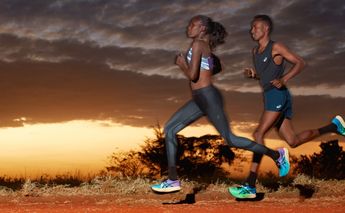Chérien Roux is a passionate amateur runner and a Sports Science graduate. Through her running journey, she's had to deal with knee pain on a personal level. What she's learned might benefit you, read on, these are her words:
Running has numerous benefits, but certain biomechanical and anatomical factors, along with running errors, can predispose people to injuries. According to Chris Napier – Clinical Assistant Professor in the Department of Physical Therapy at the University of British Columbia – up to 50% of runners experience a running related injury each year, most occurring in the lower extremities of the body due to the strain placed on the hip and legs. And, up to 28% of all running-related injuries are knee injuries. Furthermore, females are more prone to suffering from knee injuries compared to males.
Below I have explained the most common reasons why runners may experience knee pain, including the signs and symptoms and course of treatment.
Patellofemoral Pain
Patellofemoral pain is best known as runner’s knee due to the commonality of its cause by running. People who suffer from runner’s knee may experience pain behind, in front or under their kneecap (patella). Depending on the severity of their pain people may experience pain when performing daily activities such as walking, sitting or climbing stairs, but mostly when performing any running-related activity.
There are numerous reasons why people may develop a ‘runner’s knee.’ A runner’s body may struggle to adapt to a change in training regime, such as a rapid increase in running. It is important to consistently build up exercises and not go from one extreme to the other as it will place a lot of stress on your biomechanical system. Injury can be prevented, for example, by increasing your intensity every two weeks by 10-20% depending on your fitness level and years of running, thereby allowing your body to adapt. The most important aspect is not increasing the intensity by too much, because even though you feel your cardiovascular or aerobic system has improved, your muscles, joints and ligaments may still need time to adapt depending on both your anatomical and biomechanical build.
If the pain is so severe that it inhibits you from performing your daily activities, seek medical help. Otherwise, I would suggest seeing a physiotherapist to help with pain management and to provide you with rehabilitation and stretching exercises. But if the pain is only mild, I would suggest to try and avoid running or any type of exercise that causes strain to the knee for at least 2-4 weeks depending on how you feel. Furthermore, try and RICE (Rest, Ice, Compress and Elevate) the knee for the first week.
Ligament Injury
The four main ligaments of the knee act as stabilisers. Ligament injuries are usually caused when abnormal strain is placed on the knee during running. The Anterior Cruciate Ligament (ACL) injury can either be a strain or a rupture and coincide usually with a “pop” sound at the knee area. Symptoms include extreme pain and swelling at the knee followed by difficulty in putting weight on the knee and an instability of the leg. The collateral ligament is sub-divided into the Medial Collateral Ligament (MCL) and the Lateral Collateral Ligament (LCL). The MCL prevents the knee from collapsing inward while the LCL prevents the knee from collapsing outward. If you experience any of these above-mentioned signs or symptoms, I would highly recommend to see a specialist to confirm the diagnosis and provide a treatment plan. But immediate treatment is to RICE (Rest, Ice, Compress and Elevate) the knee until you can see a doctor.
Meniscus Tear
In general, the meniscus injury is one of the most common knee injuries and people from a variety of sports suffer this injury, especially high impact sports. But runners may also experience this injury especially older runners as the Menisci becomes less resilient as you age and when running and twisting the leg when your foot lands on the ground.
The most common sign and symptom of a meniscus tear is that you will hear a clicking noise when bending. Furthermore, you will experience pain and swelling on the one side of the knee (depending on what part of the Menisci is torn) and it may be difficult to put weight on that leg. As with the ACL, MCL and LCL injuries the only way to make a diagnosis is by seeing a doctor and I would highly recommend seeing the specialist when experiencing these signs and symptoms. But immediate treatment is to RICE (Rest, Ice, Compress and Elevate) the knee until you can see a doctor.
Unfortunately, most of these running-related injuries and knee pain requires medical attention and the RICE is only a short-term solution in order to prevent further damage.



